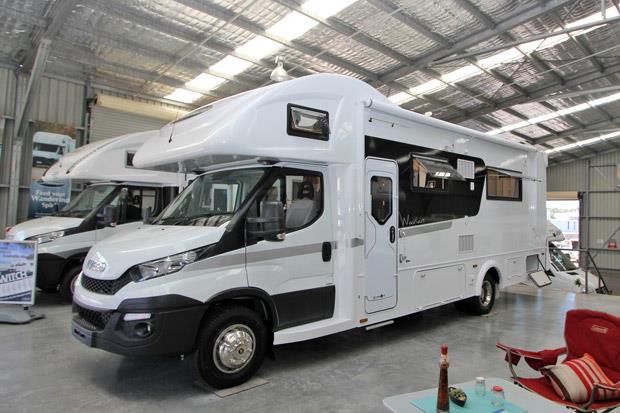B motorhomes (van conversions) built on Transit, Sprinter and Ram Promaster do not really have frames, they are unibody.
When built as cab-chassis or cutaway, as used for a "B+", C, or box truck, Sprinter and Transit cabs are put on a conventional rail frame, while the front-drive Promaster (essentially a Fiat Ducato adapted to North America) gets a special RV chassis behind the cab.
E-series and Express/Savannah vans from GM are/were body on frame. The cab-chassis and cutaway versions, dually at least, get beefed up suspension components and options for longer wheelbase than used with the van bodies. The E-350 and E-450 are also sold as bare frames, used for panel vans and some lightweight Class A motorhomes. M-B sells a dually 3500 series Sprinter bare chassis for this market as well.
The F-53/F-59 are bare chassis in Class 5 and Class 6 weight ratings (16,000 to 24,000 pounds). They are used today to make Class A gas motorhomes in North America, as well as being the platform for some specialty vehicles like rolling offices, bookmobiles, mobile medical units, mobile command posts, etc.
I've not heard of a need for a steering stabilizer on the Transit or Sprinter cab-chassis. Some people find a stabilizer or centering device useful with the E-series cutaway chassis. The F-53 has a steering stabilizer as OEM, but some customers replace that with aftermarket or a centering device, and also make other chassis modifications that may improve ride or handling, or make driving easier.
I would not expect handling problems for RVs the size of the Gemini. Unlike larger C's, these have not been extended beyond the design size of the chassis, although they are likely close to maximum weight ratings when loaded for travel.
Transit, over the years, has been well proven as a platform in the European small motorhome market (which is substantially larger than ours). Earlier generations of the Transit cab-chassis owned about 50% of the type C RV chassis market in much of Europe for a while, although Italian coachbuilders preferred FIAT's Ducato and French coachbuilders preferred Renault's Master or the Peugeot/Citroen versions of the Ducato.
This changed with the introduction of the 3rd generation FIAT Ducato/Peugeot Boxer/Citroen Jumper in 2006. The small motorhome market in Europe (i.e. within a 3.5 tonne weight limit) was ready for a modern front wheel drive chassis (front drive allows more room for the house and a lower profile) and the Ducato/Boxer/Jumper moved up to 80+% market share.
The Sprinter in Europe, since introduction of a high capacity bare chassis, has been popular as a platform for larger motorhomes, up to 5 tonne weight class. These are what we call Class A, and most of the manufacture is in Germany, where the buyers are.
Since the introduction of the 3rd generation Renault Master and 4th generation Ford Transit, the Ducato's market share has been shrinking. The Transit and Master are available front drive with ratings up to 3.5 tonnes to compete with Ducato and VW's T5 in the smaller van category, and as rear-drive or all wheel drive to compete with MB-Sprinter and VW Crafter in the market for heavier vans.
Tonne is English long ton, or metric ton, 1000 KG.
